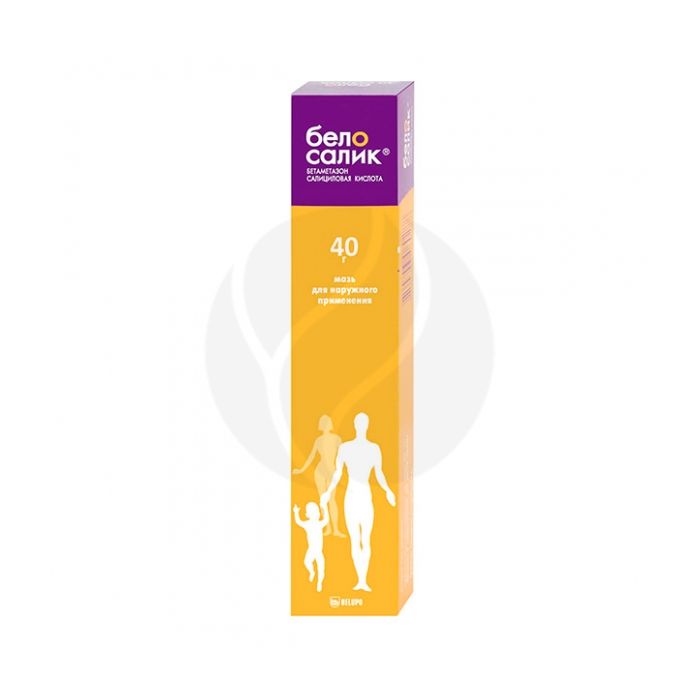Belosalik ointment 0.5 + 30mg, 40 g
Expiration Date: 11/2025
Russian Pharmacy name:
Белосалик мазь 0,5+30мг, 40 г
Psoriasis; eczema (especially chronic); ichthyosis; limited pruritus with severe lichenification; atopic dermatitis; diffuse neurodermatitis; simple and allergic dermatitis; hives; erythema multiforme; simple chronic lichen (limited neurodermatitis); dermatoses that cannot be treated with other corticosteroids (especially red warty lichen); lichen planus; dyshidrosis of the skin; seborrheic dermatitis.
Outwardly.
BelosalikЃ ointment is intended for use on smooth skin. A small amount of ointment is applied to the affected areas of the skin, lightly rubbed 2 times a day. In mild cases, a single application per day is sufficient.
The course of treatment is 3-4 weeks. If a longer use is required, the drug should be used less often, for example, every other day. In the treatment of chronic diseases, treatment should be continued for some time after the disappearance of all symptoms, under the supervision of a physician, in order to avoid a relapse of the disease. Repeated repetition of therapy is possible during the year.
Ointment for external use
active substances: betamethasone dipropionate 0.64 mg (corresponds to 0.5 mg of betamethasone) salicylic acid 30 mg auxiliary substances: mineral oil; petrolatum
Bacterial, viral and fungal skin diseases (pyoderma, syphilis, skin tuberculosis, chickenpox, herpes, actinomycosis, blastomycosis, sporotrichosis); post-vaccination skin reactions; perioral dermatitis; rosacea; trophic ulcers against the background of chronic venous insufficiency; skin tumors (skin cancer, nevus, atheroma, epithelioma, melanoma, hemangioma, xanthoma, sarcoma); pregnancy; lactation period (do not apply to the skin of the breast before feeding); children's age up to 1 year; hypersensitivity to betamethasone or salicylic acid.
With care
Liver failure, childhood (over 1 year), long-term therapy, especially with the use of occlusive dressings.
pharmachologic effect
Combined drug for external use, the action of which is due to its constituent components. It has anti-inflammatory, anti-edema, antiallergic, vasoconstrictor, antiproliferative, immunosuppressive, keratolytic, antimicrobial, antifungal and local hypothermic effects. It inhibits the release of inflammatory mediators, prevents the marginal accumulation of neutrophils, reduces inflammatory exudate and cytokine production, reduces the migration of macrophages, leading to a decrease in the processes of infiltration and granulation.
Due to the presence of salicylic acid, it softens the skin, eliminates horny layers and promotes deeper penetration of GCS.
The ointment is water-repellent and forms a protective film that protects the skin from external moisture; possessing a deep fat-saturating effect, it is most suitable for the treatment of patients with dry and fragile skin.
The lotion (solution in a fat-free base) spreads easily on the surface of the skin, does not stick or dry out the hair, does not leave visible marks, and has a cooling effect on the skin.
Indications of the active substances of the drug BelosalikЃ
Psoriasis; eczema (especially chronic); ichthyosis; limited pruritus with severe lichenification; atopic dermatitis; diffuse neurodermatitis; simple and allergic dermatitis; hives; erythema multiforme; simple chronic lichen (limited neurodermatitis); dermatoses that cannot be treated with other corticosteroids (especially red warty lichen); lichen planus; dyshidrosis of the skin; seborrheic dermatitis.
Side effect
Local reactions: burning, irritation, dryness, hypopigmentation, itching of the skin, folliculitis, hypertrichosis, acne.
When using occlusive dressings - skin maceration, striae, skin atrophy, secondary infection, prickly heat.
With prolonged use - skin atrophy, local hirsutism, telangiectasia, purpura, hypopigmentation, hypertrichosis.
Systemic reactions: when applied to large surfaces, systemic manifestations of side effects of GCS are possible (growth retardation, Itsenko-Cushing's syndrome, benign increase in intracranial pressure after the end of treatment, hyperglycemia, glucosuria, hypokalemia, increased blood pressure) or salicylates (pallor, fatigue, drowsiness, hyperventilation against the background of tachypnea, nausea, vomiting, hearing impairment, confusion).
Contraindications for use
Bacterial, viral and fungal skin diseases (pyoderma, syphilis, skin tuberculosis, chickenpox, herpes, actinomycosis, blastomycosis, sporotrichosis); post-vaccination skin reactions; perioral dermatitis; rosacea; trophic ulcers against the background of chronic venous insufficiency; skin tumors (skin cancer, nevus, atheroma, epithelioma, melanoma, hemangioma, xanthoma, sarcoma); pregnancy; lactation period (do not apply to the skin of the breast before feeding); children's age up to 1 year; hypersensitivity to betamethasone or salicylic acid.
With care
Liver failure, childhood (over 1 year), long-term therapy, especially with the use of occlusive dressings.
Application during pregnancy and lactation
Contraindicated for use during pregnancy and lactation (do not apply to the skin of the breast before feeding).
Application for violations of liver function
With caution : liver failure.
Application in children
Contraindication - children under 1 year of age.
With caution : children (over 1 year old).
The use of the ointment in children should be as short as possible (the danger of systemic absorption of a proportionally larger amount of active components due to the predominance of the area of ??the skin over the body weight and insufficient maturity of the epidermis).
special instructions
Avoid contact with the eyes, do not apply to the skin near the eyes and mucous membranes.
Long-term use on the face is not recommended - it is possible to develop dermatitis like rosacea, perioral dermatitis, skin atrophy and acne; avoid use in the anogenital area.
The use of the ointment in children should be as short as possible (the danger of systemic absorption of a proportionally larger amount of active components due to the predominance of the area of ??the skin over the body weight and insufficient maturity of the epidermis).
If signs of allergic reactions or local irritation appear, treatment should be discontinued.
Drug interactions
The simultaneous use of cosmetic and dermatological products for the treatment of acne, products containing ethanol, or medical soaps with a pronounced drying effect can cause skin irritation in certain cases.

